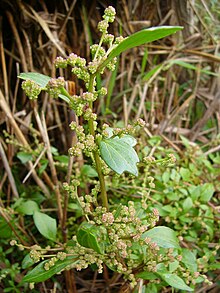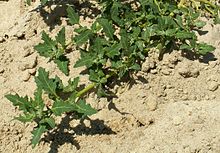Oxy base
| Oxy base | ||||||||||||
|---|---|---|---|---|---|---|---|---|---|---|---|---|

Red goosefoot ( Oxybasis rubra ) |
||||||||||||
| Systematics | ||||||||||||
|
||||||||||||
| Scientific name | ||||||||||||
| Oxy base | ||||||||||||
| Kar. & Kir. |
Oxybasis is a genus of plants in the subfamily Chenopodioideae within the foxtail family(Amaranthaceae). It was established in 1841, but only rewritten in 2012. It includes five species that were previouslycounted amongthe goosefoot ( Chenopodium ) and are common in Eurasia , North Africa and North America .
description


Vegetative characteristics
Oxy base species are annual herbaceous plants with no aromatic fragrance. The branched stems grow upright, ascending or spread out, the lowest side branches are sometimes almost opposite.
The alternate leaves are arranged in a petiole and a leaf blade and are more or less bare, sometimes densely floured on the underside. Their thick, slightly fleshy leaf blades can be triangular, narrow-triangular, spear-shaped, rhombic or lanceolate. The leaf margin is smooth or serrated.
Generative characteristics
The flowers are located in compact, ball-shaped partial inflorescences, which are arranged in pseudo-eared, less often paniculate, axillary or terminal inflorescences . There are two types of flowers: The flowers at the end of the ball are hermaphroditic, with three to five bracts , most of which are unconnected. They have one, rarely up to five stamens . On the upper permanent ovary there are two or rarely three scars. The lateral flowers, on the other hand, are almost always purely female, with three (to four) bracts of different strengths and two stigmas.
The membranous pericarp is free or only loosely adheres to the seed coat. The seed of the terminal flowers is oriented horizontally, in the side flowers it can be vertical or horizontal. Its shape is ovoid to spherical with a rounded edge. The brownish or black seed coat can be almost smooth or have a fine mesh pattern or tiny pits.
Systematics and distribution
The genus Oxybasis is like Chenopodium by Fuentes-Bazan et al. (2012) assigned to the Atriplicieae tribe . It belongs to the subfamily Chenopodioideae within the Amaranthaceae family .
The first description of the genus Oxybasis was in 1841 by the Russian botanists Grigori Silytsch Karelin and Ivan Petrovich Kirilov . At that time the genus contained as the only species Oxybasis minutiflora Kar. & Kir. which was later considered identical to Chenopodium chenopodioides .
After molecular genetic studies, Suzy Fuentes-Bazan , Pertti Uotila and Thomas Borsch separated the species group around Chenopodium rubrum from the genus Chenopodium in 2012 and placed it in the genus Oxybasis , since this is the oldest genus name for this group.
Synonyms for Oxybasis Kar. & Kir. are Chenopodium subg. Pseudoblitum Gren. & Godr. , Blitum subg. Pseudoblitum (Gren. & Godr.) Schur , Chenopodium sect. Pseudoblitum (Gren. & Godr.) Syme , Chenopodium [without rank] Rubra Standl. , Chenopodium [without rank] Glauca Standl. , Chenopodium subsect. Glauca (Standl.) AJ Scott , Chenopodium sect. Glauca (Standl.) Ignatov , Chenopodium [without rank] Urbica Standl. , Chenopodium sect. Urbica (standl.) Mosyakin , as well as Chenopodium sect. Degenia Aellen .
The genus Oxybasis is common in Eurasia , North Africa , North and South America .
The genus oxybasis comprises by Fuentes-Bazan et al. 2012 five types:
- Thick-leaved goosefoot ( Oxybasis chenopodioides (L.) S.Fuentes, Uotila & Borsch , Syn .: Chenopodium chenopodioides (L.) Aellen ): It occurs in Eurasia and North Africa. It is a neophyte in North and South America.
- Gray-green goosefoot ( Oxybasis glauca (L.) S. Fuentes, Uotila & Borsch , Syn .: Chenopodium glaucum L. ): It occurs in Eurasia and North America.
- Oxybasis macrosperma (Hook. F.) S.Fuentes, Uotila & Borsch , (Syn .: Chenopodium macrospermum Hook. F. ): The species iswidespreadin South America and the Falkland Islands .
- Red goose foot ( Oxybasis rubra (L.) S. Fuentes, Uotila & Borsch , Syn .: Chenopodium rubrum L. ): It is widespread in Europe, the temperate areas of Asia and North America and occurs as a neophyte in other areas.
- Street goose foot ( Oxybasis urbica (L.) S. Fuentes, Uotila & Borsch , Syn .: Chenopodium urbicum L. ): It occurs in Eurasia and is a neophyte in North America.
swell
- Susy Fuentes-Bazan, Pertti Uotila, Thomas Borsch: A novel phylogeny-based generic classification for Chenopodium sensu lato, and a tribal rearrangement of Chenopodioideae (Chenopodiaceae). In: Willdenowia. Volume 42, 2012, pp. 15-16, DOI: 10.3372 / wi42.42101 .
Individual evidence
- ↑ Grigori Silytsch Karelin, Ivan Petrovich Kirilov: Enumeratio plantarum anno 1840 in regionibus altaicis et confinibus collectarum. (Continuatio.) In: Bulletin de la Société Impériale des Naturalistes de Moscou. Volume 14, No. 4, 1841, pp. 705-870 (here: pp. 738-739 ).
- ↑ a b c d Oxy base in the Germplasm Resources Information Network (GRIN), USDA , ARS , National Genetic Resources Program. National Germplasm Resources Laboratory, Beltsville, Maryland. Retrieved September 15, 2017.
- ^ Pertti Uotila: Chenopodium urbicum . In: Karl Heinz Rechinger et al. (Ed.): Flora Iranica. Volume 172 - Chenopodiaceae . Akademische Druck- und Verlagsanstalt, Graz 1997, ISBN 3-201-00728-5 , pp. 36–37.